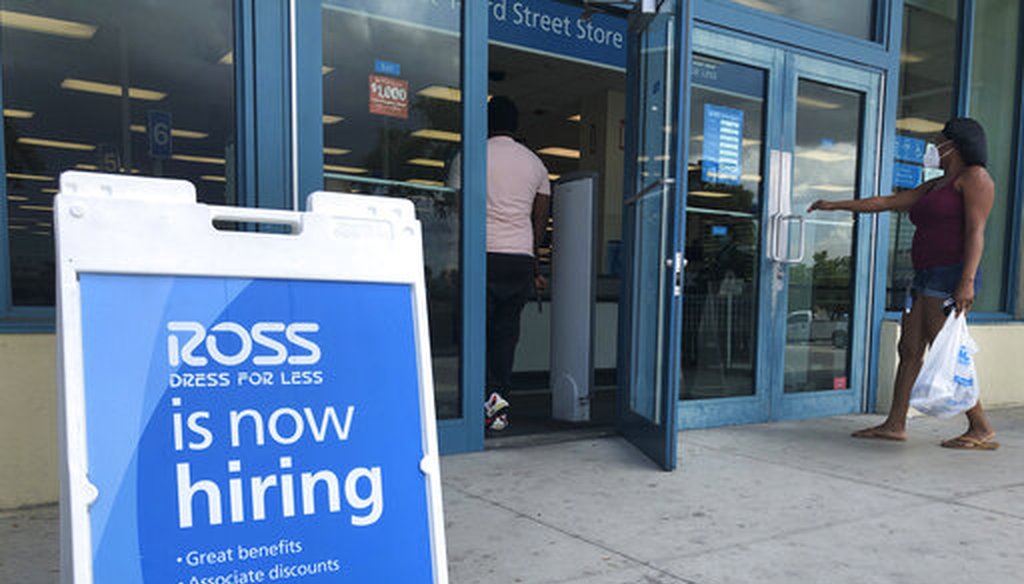



A "Now Hiring" sign sits outside a Ross Dress for Less store in North Miami Beach, Fla., on July 8, 2020. (AP)
In his Democratic convention address, former President Bill Clinton took a shot at President Donald Trump’s economic record during the coronavirus pandemic, saying the 45th president has botched his handling of the twin health and economic crises.
"Donald Trump says we’re leading the world," Clinton said. "Well, we are the only major industrial economy to have its unemployment rate triple."
Using the most clear-cut multi-nation comparison — comparing January to June 2020 — Clinton is right. But it’s worth noting some differences in how countries address unemployment.
We turned to data from the Organization for Economic Cooperation and Development, a think tank whose members are advanced industrialized countries. The group collects economic statistics for all its members, including unemployment rates. We chose 20 countries for which data was available, including most of the countries in western Europe, plus Canada, Australia, Japan, South Korea, and Israel.
For consistency’s sake, we compared January to June because only two of the countries reported data for July.
As the following chart shows, the United States was among the few countries to show a dramatic increase in the unemployment rate between January and June. The U.S. is the peach-colored line with the steep climb; you can see each country highlighted if you hover over the list of countries at the bottom.
The United States saw its unemployment rate increase from 3.6% to 11.1%. That works out to a little under 3.1 times higher in June than January.
No other country saw such a big increase.
The only other nation that saw its unemployment rate more than double over that period was Canada, which saw its rate increase 2.2 times. Canada actually had a higher unemployment rate in June than the U.S. did, at 12.3%, but the scale of Canada’s increase was more modest than the United States’ because Canada had a higher rate to start, at 5.5%.
Using U.S. data for February instead of January doesn’t change the picture much. The U.S. unemployment rate in February was 3.5%, making the increase through June about 3.2 times.
There are a couple asterisks to Clinton’s statement.
If you compare January to July, a month for which data isn’t available for most of the OECD nations, the increase in the United States was still substantial, but just short of three times higher. The unemployment rate rose from 3.6% in January to 10.2% in July, meaning an increase of 2.8 times.
It’s also worth noting that the U.S. unemployment rate has fallen for three straight months, amid a zigzagging reopening and a volatile economy. So the unemployment rate is likely to bounce around a bit before it settles down.
Finally, the OECD itself notes some differences across countries. Some nations have used more aggressive efforts than the United States to subsidize workers to remain on payrolls. And some countries, such as the United Kingdom, do not count "temporarily" laid-off workers as unemployed, while the United States does count such workers as unemployed.
Clinton said the United States is "the only major industrial economy to have its unemployment rate triple" since the coronavirus pandemic began.
That’s accurate for the broadest comparison — a 20-nation selection of OECD nations between January 2020 and June 2020. The rate in the U.S. was 3.1 times higher in June than in January. Only Canada came close, with the unemployment rate 2.2 times higher over that period.
However, extending the U.S. data to July showed that the increase fell slightly below three times, and there are some complications in making cross-country comparisons.
We rate the statement Mostly True.
UPDATE, Aug. 20: This article has been updated with additional context about the complications of making cross-country comparisons of unemployment rates. The rating remains the same.
Bill Clinton, remarks at the Democratic convention, Aug. 18, 2020
Organization for Economic Cooperation and Development, national unemployment rates, accessed Aug. 18, 2020
Federal Reserve Bank of St. Louis, unemployment rate, accessed Aug. 18, 2020
In a world of wild talk and fake news, help us stand up for the facts.
